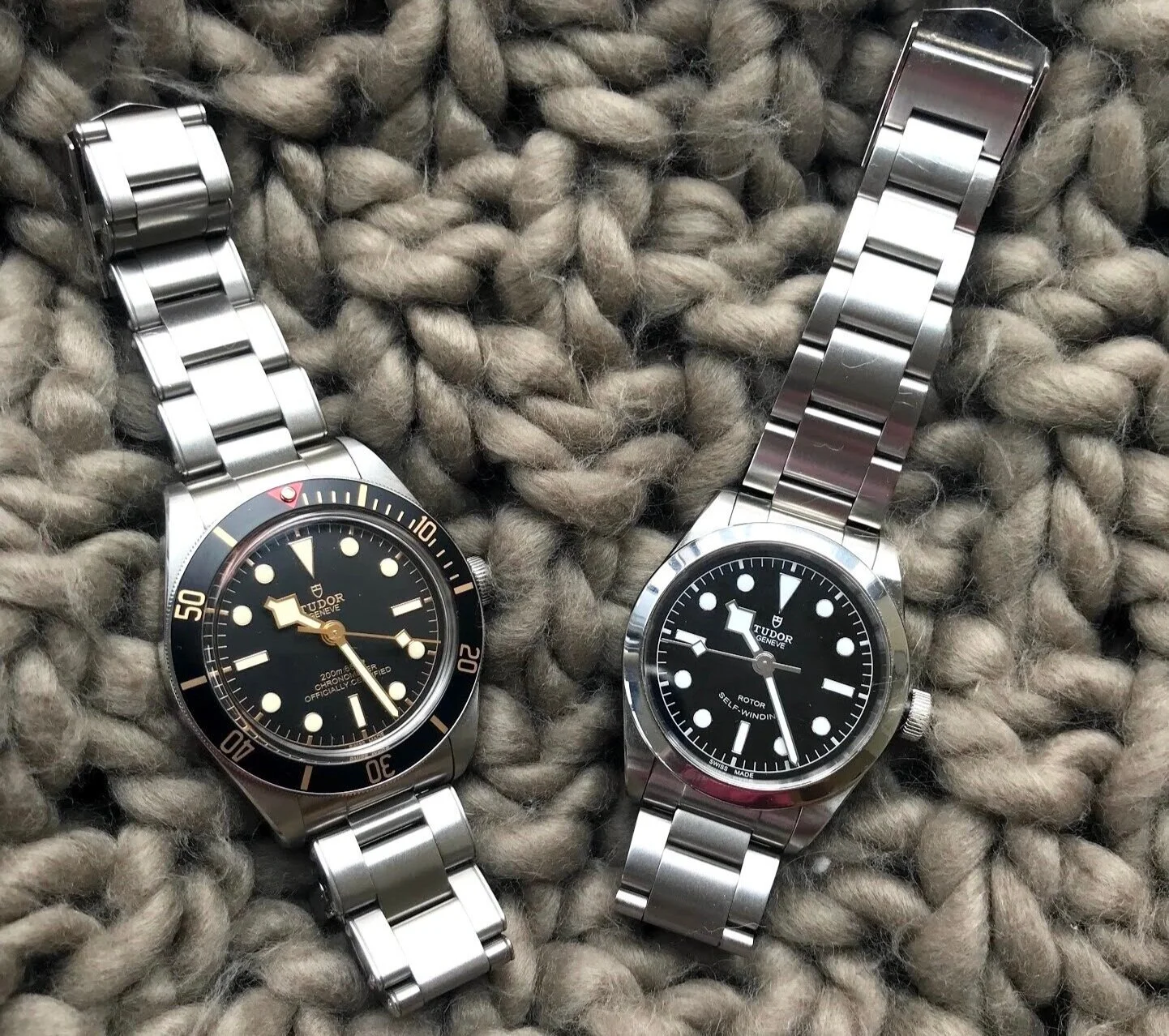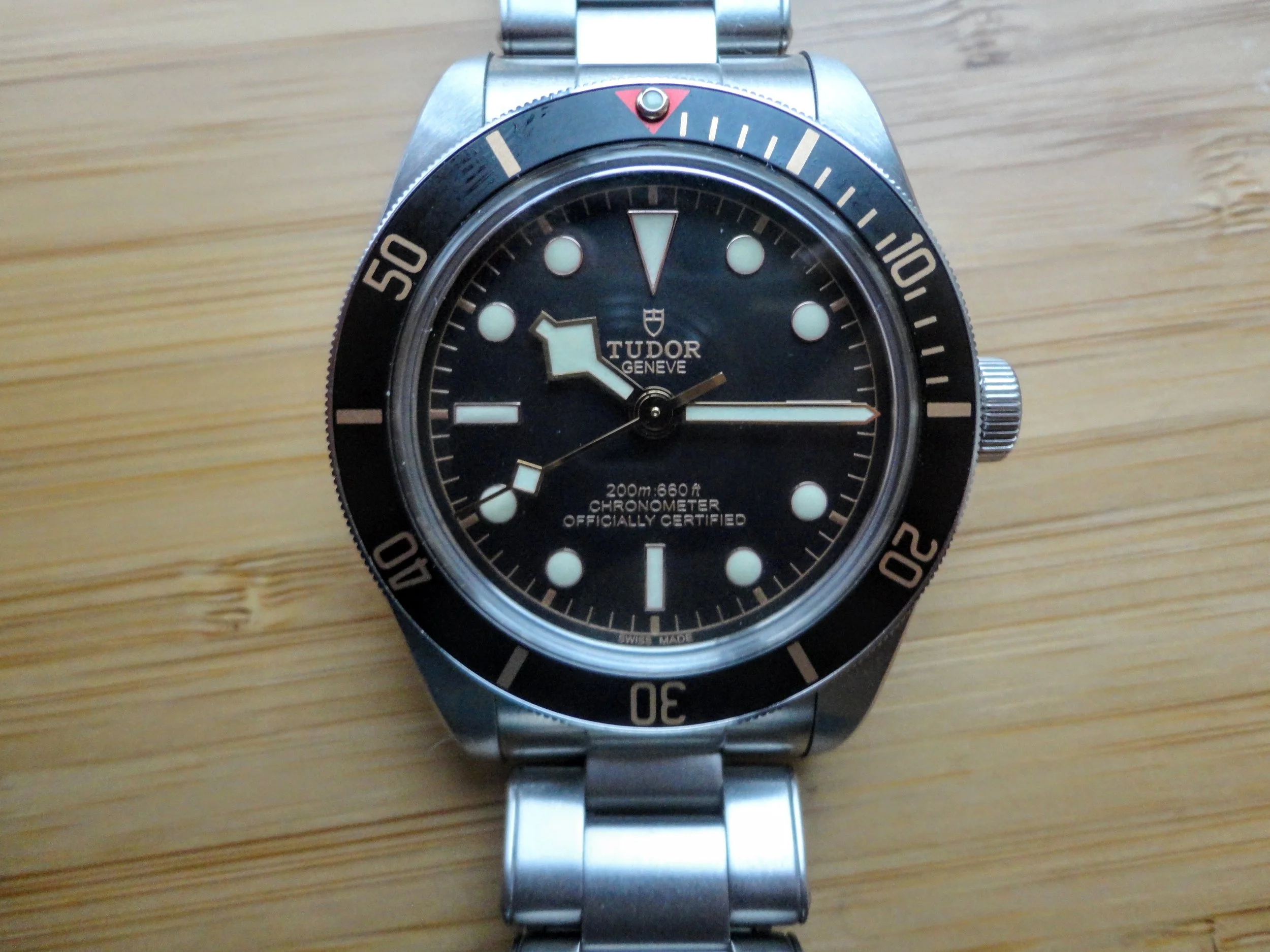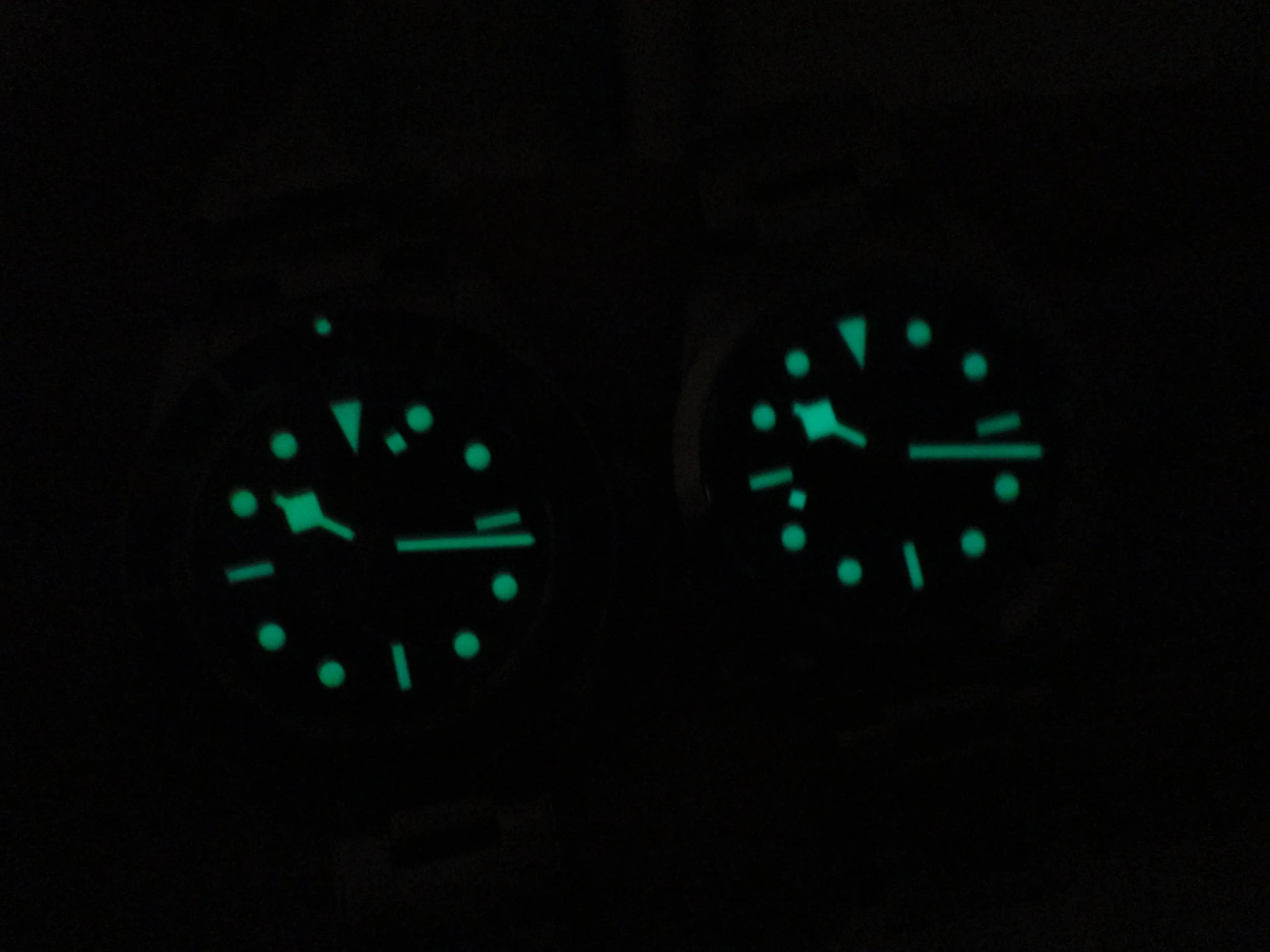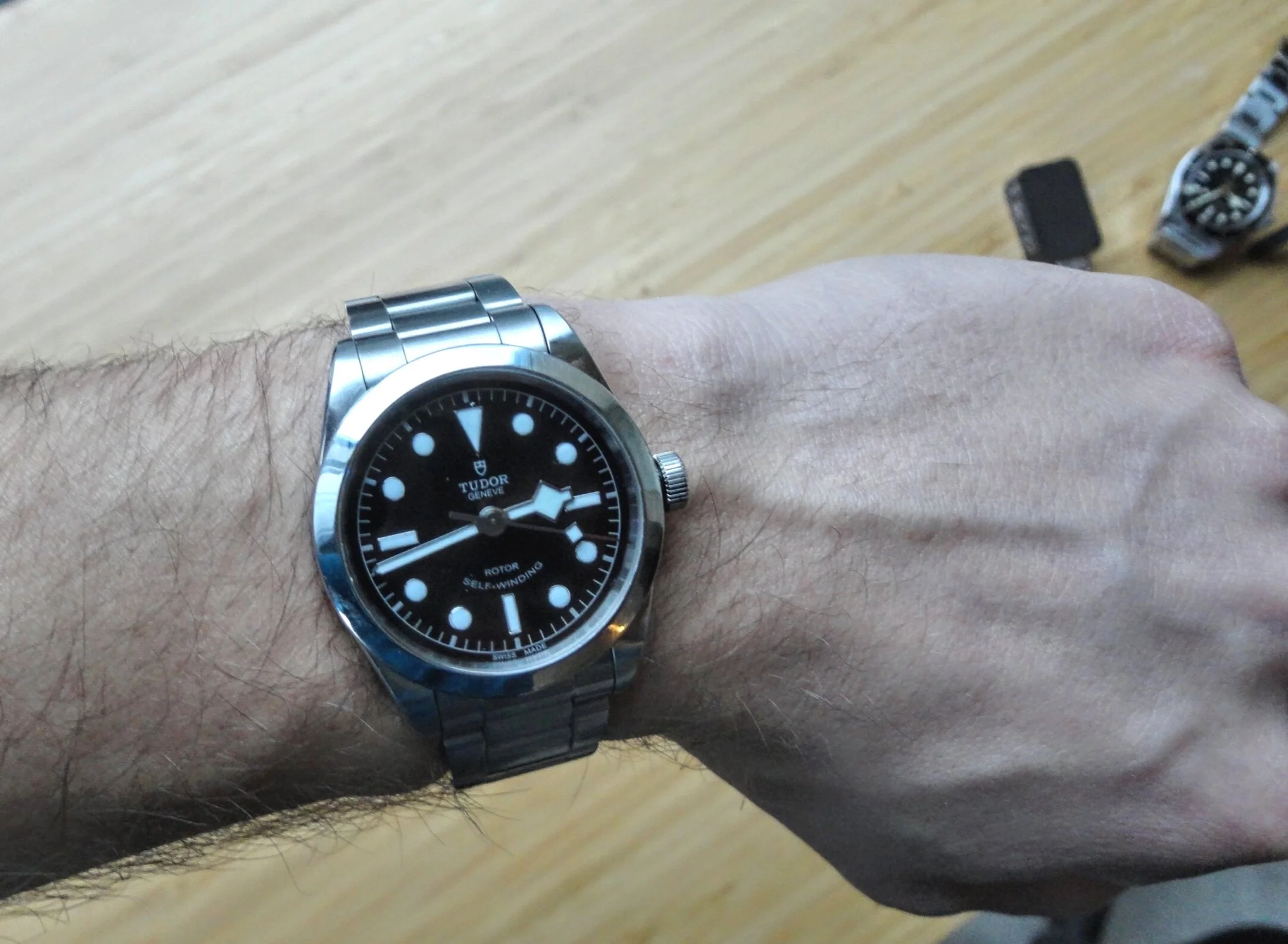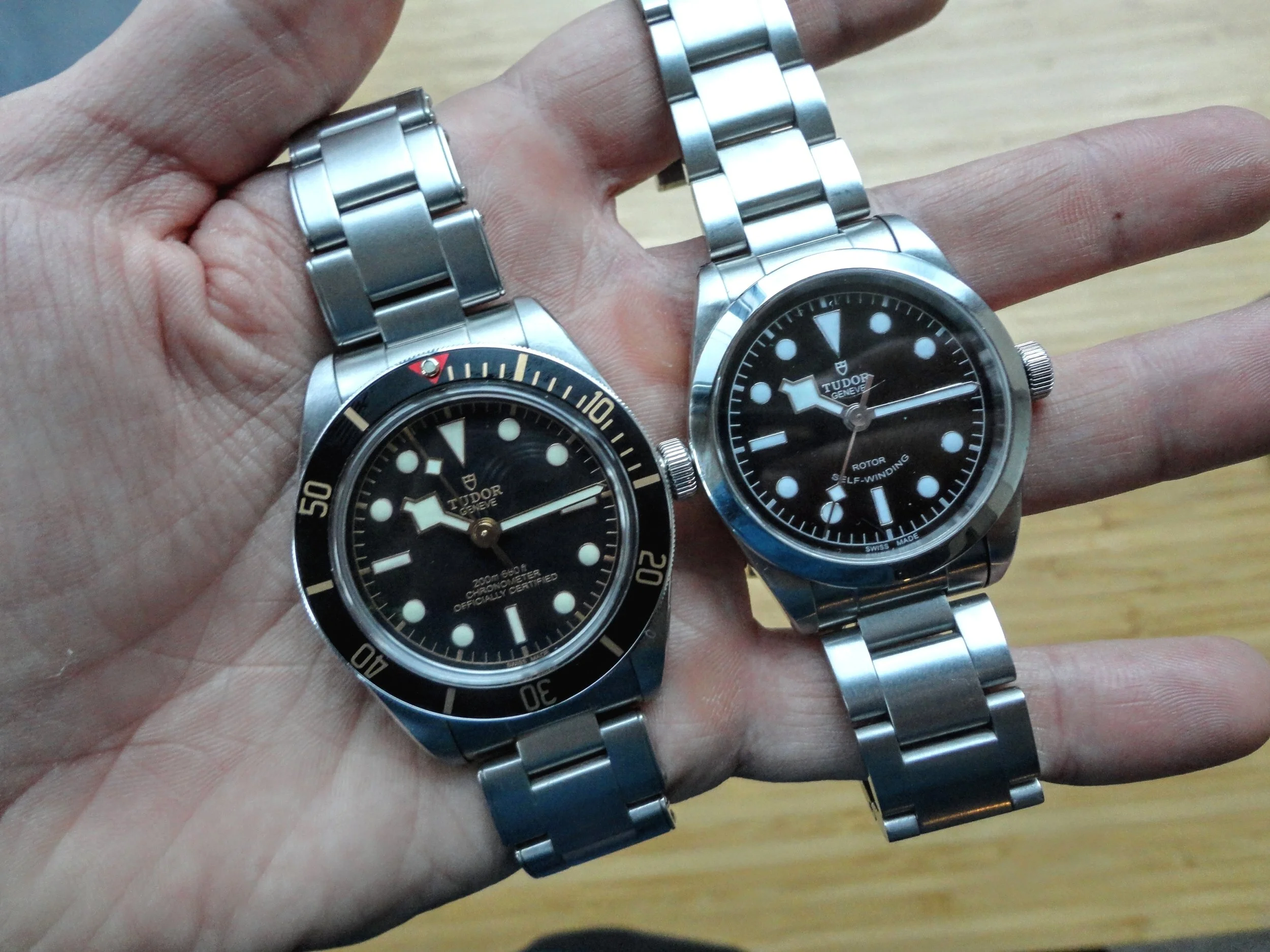Subscribe to our weekly newsletter, a fine newsletter about important watches.
Like most, I’ve been in love with the Tudor Black Bay 58 (Ref. M79030N-0001) since it was released at Baselworld in 2018. The “58” is a reference to the vintage Tudor the new Black Bay 58 is modeled after, the Reference 7924 “Big Crown”; read our history of the Tudor Submariner here for more. While a little more under-the-radar, I’ve also had my eye on the slightly smaller and bezel-less Tudor Black Bay 36 (Ref. M79500) since it was released at Baselworld 2016. Instead of deciding to purchase just one watch like a normal person, right now I have both, like a real watch idiot savant. But I only have room in my collection for one Tudor Black Bay.
I’d be willing to bet others have had to make similar decisions between the Black Bay 36 and Black Bay 58, or another similar comparison, like the Black Bay 41 and Black Bay (and its various colorways— shout out Harrod’s for the fire collab). So, I decided to write an article comparing the two: case, dial, movement, the whole kit. To be honest, as I set out to write this post, I still haven’t decided which Black Bay I’m going to keep and which I’m going to sell, but hopefully this exercise will help me decide.
Match Up 1: The Movements
First, let’s talk movement specs:
Black Bay 36: Regulated automatic ETA 2824 movement (not COSC certified); 38 hour power reserve
Black Bay 58: Manufacture Calibre automatic MT5402 (COSC certified); 70 hour power reserve
Okay, purists are going to point to the dope new in-house MT5402 that Tudor developed for the Black Bay 58 as the obvious winner here. The smaller, thinner movement allowed them to drop the thickness of the Black Bay 58 to just 11.9mm, compared to 14.75mm for the original Black Bay line. On top of that, Tudor managed to make it a certified COSC chronometer, meaning it’s a super accurate watch come hell or high water. But Tudor has also done great work packing a super-accurate ETA movement into the Black Bay 36.
In my non-scientific studies (I won’t show my spreadsheet, but yes, I have one), my Black Bay 36 has never been more than two seconds off over a 24-hour period. That’s pretty impressive for what some will degrade as an “off-the-shelf” movement. Listen, Tudor takes those ETA movements and modifies them pretty heavily to meet its own internal specifications. Stick your nose up at the out-house movement all you want, it gets the job done. What bothers me more about the ETA 2824 movement is the paltry 40-hour power reserve. I love both of these watches because they make great everyday wears — equally at home with a t-shirt and jeans as with office wear — but I’ll often wear an Apple Watch or Seiko 5 all weekend and put the Tudor in the watch box. Come Monday morning, the Black Bay 58 and its 70-hour power reserve are still good to go. Meanwhile, the Black Bay 36 has stalled and needs setting. It’s a tiny inconvenience, but hey — I’m writing 1,000 words comparing two watches, what’d you expect?
Winner: Both movements are winners, the question is whether you’re willing to pay a slight premium for an in-house COSC movement with a better power reserve. If price isn’t a concern, the Black Bay 58’s in-house movement is objectively a better caliber.
Match Up 2: The Dials
First, the specs:
Black Bay 36: glossy black dial, steel/silver finishings, flat crystal
Black Bay 58: “matte” black dial, gilt/gold finishings, domed crystal
In concept, the dials of the Black Bay 58 and Black Bay 36 are similar: inspired by the Tudor Submariners of old, they have white triangle markers at 12 o’clock, sticks at 3-6-9, and dots at the other hours. In execution, the dials couldn’t be more different, especially in person.
The Black Bay 36 looks thoroughly modern: the dial is a glossy black that shines when light hits it. The steel accents on the white lume give it a sporty, modern finish, capped off by the silver outer track. There’s not much text on the Black Bay 36, lending the dial a minimalist aesthetic. The silver print provides a stark, clean contrast to the black dial. The arched “self-winding” printed above the 6 o’clock is a real highlight of the dial, and frankly I’m a little pissed they did away with this for the Black Bay 58. The way the seconds hand slides right below the text as it ticks around the dial is just mesmerizing.
Meanwhile, the Black Bay 58 is a throw back — which is why it’s gotten so much love. The matte black dial of the Black Bay 58 doesn’t shine like the Black Bay 36, seemingly absorbing the light and giving the whole watch a certain warmth. The rose gold accents on the lume and outer track only add to this warmth and the overall vintage gilt look of the watch. The Black Bay 58 is more text-heavy at the 6 o’clock position, with the COSC certification and water resistance written in gilt print. I’ll talk about the bezel below, but the gilt print on the bezel really finishes off the vintage look of the Black Bay 58. It’s hard to think of another watch that has executed so well on paying homage to the vintage model it is referencing, while adding a certain modern flair to distinguish itself. While the Black Bay 58 has the more modern-style flat crystal, the Black Bay 58 has a noticeable dome, a shoutout to the style of generations gone. I don’t hate it.
Winner: This is tough. Vintage enthusiasts will prefer the gilt-style Black Bay 58, but the clean and modern Black Bay 36 just comforts me. It doesn’t try to be anything it’s not, which is a good, honest modern Swiss sport watch.
Match Up 3: Case and Bracelet
Let’s talk specs again:
Black Bay 36: 36mm x 10.5mm, 19mm lug width, stainless steel case, satin finish, smooth polished bezel, 150m waterproofness, rivet-style bracelet; weight (on bracelet): 117 grams
Black Bay 58: 39mm x 11.9mm, 20mm lug width, stainless steel case, polished and satin finish, unidirectional rotating bezel, 200m waterproofness, oyster-style bracelet; weight (on bracelet): 129 grams
The oyster-style cases of both Black Bays means they’re sufficiently waterproof, so that’s not a differentiating factor between these two watches. Additionally, points to both for the classic Tudor snowflake hands. The biggest external difference between the two is obviously the bezel on the Black Bay 58. Making the decision between bezel and no bezel may come down to a matter of personal preference. But, a mere 18 months ago I never thought I’d be a bezel guy; I was wearing a Bauhaus-style 35mm watch every day. If any watch is going to make you love the bezel life, it’s this one. Sitting just 11.9mm thick, the Black Bay 58 wears like a dream, and this is coming from a guy with small wrists (about 6.75in). It’s right on the borderline of feeling like a hockey puck on my wrist, so I’m glad they didn’t go any bigger. I never thought a true dive watch with a rotating bezel would look good on my wrist, but this one pulls it off, sitting flush against the skin. The stainless steel crown stem finishes off the vintage styling of this watch. The lugs seem slightly more beveled (or chamfered?) compared to the Black Bay 36 which give it just a bit more texture.
The Black Bay 58 features a rivet bracelet, adding some nice character to the standard oyster-style bracelet. It also has more of a brushed finish than the standard Tudor/Rolex bracelets, again giving it more of that matte/vintage look. The 20mm lug width is perfect and means you’ll have no difficulty finding straps to swap out if you so desire.
Like the Black Bay 58, it’s hard to say stress how comfortable the Black Bay 36 is on wrist. the slightly smaller dimensions work for me and it sits perfectly flat on wrist. The stainless steel case and bracelet have a shinier finish compared to the Black Bay 58 — again, the modern v. vintage contrast. The bracelet of the Black Bay 36 is a classically polished oyster-style stainless steel. To me, the Black Bay 36 seems to wear a little more comfortably than the 58. It’s slightly smaller and lighter, and seems to naturally slide over the sweet spot on my wrist, and I never feel weighed down. It’s one of the most comfortable watches I’ve ever worn. The only thing to knock about the Black Bay 36 is the 19mm lugs. Like wtf, why? If I buy a strap for this watch, it’s going to be just for this watch, because I don’t know many other watches with this lug width.
Winner: The case and bracelet of the Black Bay 58 are just too on point. The riveted bracelet and more exaggerated beveled lugs work perfectly with the matte finishing of the stainless steel to give the watch these interesting textures that play with the light really well. While the Black Bay 36 has a quintessentially modern case and bracelet, there’s nothing particularly unique to them — they can be found up and down the Rolex and Tudor catalogs, as well as the catalogs of many competitors. You can’t say that about the Black Bay 58.
Comparing the mock rivets of the Black Bay 58’s bracelet to the classic oyster-style bracelet on the Black Bay 36
Left: 58; Right: 36
Match Up 4: The Value
Let’s be honest for a minute. If you’re deciding between a couple Tudors, you’re probably doing it for the value. You’re not at a place where you want to go all in for a Rolex, but you’re close. Or perhaps you think people people who wear Rolexes are douchebags. Both are perfectly acceptable states of mind. That just means you might be weighing this category more than the others. First, let’s talk MSRP:
Black Bay 36: $2,850 (with bracelet — always get the bracelet)
Black Bay 58: $3,575 (with bracelet)
On the pre-owned market, the Black Bay 36 can be found closer to $2,000. There are still waitlists at ADs (as of March 2019) for the Black Bay 58, so you’re not going to get much of a discount, though you’ll save on taxes. Both offer great value for the money — yes, you can argue that the Black Bay 36 at MSRP isn’t a great value, and that’s might be true — and neither really have any direct competitors. At MSRP, it’s really hard to dispute that the Black Bay 58 is a better value. For $700 more than the Black Bay 36, you get a true dive watch with an in-house movement that’s an heir to the Submariner lineage and probably the best non-Rolex Submariner lookalike out there (at a fraction of the price).
This is not to say that the Black Bay 36 isn’t a legit sport watch, because it is. It hits the sweet spot between a Rolex Explorer and Rolex Submariner (and at a vintage 36mm size) that no other watch has ever really tried. Considering the Explorer 1016 or 6610 is my grail, this is no small compliment. To get a versatile watch like this for $2,000 pre-owned is a near steal. Further, you can argue that the Black Bay 36 is slightly more versatile than the Black Bay 58: it’s 1 mm thinner, and, without a bezel, it dresses up more easily than the 58. Unrelated, it’s possible Tudor could release the Black Bay 36 with an in-house movement in the next couple years — I think the MT5402 they developed for the Black Bay 58 could squeeze into the Black Bay 36 cases right now (they may need to bubble the caseback just a touch).
Winner: Any good economist will tell you that value is not the same as market price. The consumer surplus derived from any transaction is consumer-specific. Personally, I picked up a pre-owned Black Bay 36 for a good deal, so it wins the value match up. At MSRP, the Black Bay 58 wins.
Match Up 5: The Intangibles
Match Ups 1-4 give the tale of the tape. Besides great specs, both of these watches are also supremely comfortable on wrist. I’d never even owned a bracelet before I purchased the Black Bay 36. Now I don’t know if I can ever go back. For my small wrist, 36mm is the perfect size. It’s too comfortable on wrist — I sleep with it on. I thought the 39mm Black Bay 58 might be a little big for me, but really it doesn’t wear that much larger than the 36mm, with the black bezel making it feel a bit smaller. you’ll hear complains about the high, straight midcase of the Black Bay 58, but even as someone who’s a stickler for a svelte watch, it didn’t both me.
The Black Bay 36 is a subtle watch that blends in perfectly with my day. It’s so comfortable I forget I have it on, but am always joyed when I think “oh what time is it” and take a quick glance at the glossy black dial.
The Black Bay 58 is equally comfortable, but I feel like a boss with it, both because of what’s on the inside and the outside. It’s probably the hottest under-$4,000 watch in the world, and anyone who’s into watches at all is going to give it a second look and a slight grin. But who cares what others think, right? I love the feeling of having a little secret inside when that secret is a super accurate in-house caliber. When I’m wearing the Black Bay 36, I feel like I have a secret too, but it might be the bad kind: inside is an ETA 2824, a movement that can be found in watches a quarter of the price. At the end of the day I don’t really care because the case and bracelet build of the Black Bay 36 punches well above its weight. But like a life partner, I’d prefer a watch that’s got the whole package when push comes to tick.
Winner: Black Bay 36. Here’s the other issue with the Black Bay 58: it might just be trying a little too hard to be something it’s not, namely: vintage, and a Rolex. Perhaps the only thing worse than being the type of bro that unabashedly pays2x retail a Rolex is being the type of bro that wears an almost Rolex. Whenever I clasp on the Black Bay 58, I get that feeling. Not around other watch idiots, to be sure, but when the general public sees it (“normies,” as it were). The Black Bay 36 is perfectly comfortable with its position: a sporty 36mm watch with all the features of a modern timepiece. There’s something to be said for a watch that knows what it is and doesn’t shout it from the roof tops. I’m a normcore type of guy: it’s white t-shirts or OCBDs and jeans most days I’m not in the office. The Black Bay 36 is more of a normcore watch that fits my lifestyle; the Black Bay 58 is a bolder style than I’m comfortable with on a day-to-day basis.
Overall Black Bay Winner
For those not keeping score, here’s where we’re at:
Black Bay 36: 3 (dial, value, intangibles)
Black Bay 58: 2 (movement, case and bracelet)
As I mentioned, value is a subjective judgement based on the individual consumer, so your winner in that category may be different based on what you value and how much you purchase your Black Bay for. Reviewing my review though, I think I generally agree with the result. It makes sense that I like the more modern dial execution of the Black Bay 36 compared to the gilt Black Bay 58. There’s nothing like the good, honest patina of a vintage dial, and much as the Black Bay 58 tries — and it does a good job, to be clear — it can’t replicate that. On the other hand, the matte stainless steel finishing and details of the Black Bay 58’s case and bracelet case give it a character not seen anywhere else in modern watches right now. The “intangibles” category was a close call for me: both have something working for them outside the physical specs. But there’s something about wearing a great modern, stainless steel sports watch that’s not trying to be anything it’s not that appeals to me. And that’s exactly what the Black Bay 36 is. The defining watches of the previous generation all fall into this category: Paul Newman, Steve McQueen, even Pablo Picasso. The Tudor Black Bay 36 is my minimalist effort to squeeze into this pantheon, even if only in my own mind.
Then again, maybe there is room for two Tudor Black Bays in my collection.
